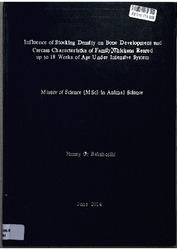| dc.description.abstract | The influence of stocking density on bone development and carcass characteristics of family
chickens was investigated. A total of 232 unsexed day-old family chicks were used in a
completely randomized design. Birds were randomly assigned to four stocking densities,z.e., DI
(10 birds/m2), D2 (13 birds/m2), D3 (16 birds/m2) and D4 (19 birds/m2) in the first phase (0-6
weeks). Each treatment was replicated four times. Two birds were slaughtered at 6, 12 and 18
weeks of age from each replicate to evaluate bone length, bone width, bone weight, bone
chemical composition (ash weight, Ca%, P%, Mg%) and carcass characteristics. In the second
phase (At*., from 7 to 12 weeks of age) the stocking densities were 8 birds/m2 (DI), 11 birds/m2
(D2), 14 birds/m2 (D3) and 17 birds/m2 and 6 birds/m2(DI), 9 birds/m2 (D2), 12 birds/m2 (D3)
and 15 birds/m2 (D4) in the final phase, from 13 to 18 weeks of age. General Linear Model
(GLM) procedure of Statistical Analysis System was used to estimate the differences between
treatment means for different stocking densities. Stocking density in all the three phases did not
have a significant (p>0.05) effect on bone dimensions. Tibia length, width and weight, and
humerus length, width and weight in the first phase ranged from 75.71 to 78.41 (± 17.31) mm,
4.80 to 5.25 (± 4.21) mm, 4.25 to 4.63 (± 2.77) g, 54.02 to 55.52 (± 1.71) mm, 5.10 to 5.56 (±
1.69) mm and 2.06 to 2.63 (± 1.34) g, respectively. In the second phase, the length, width and
weight of both tibia and humerus ranges, following the same order as in the first phase, were
125.82 to 131.33 (±43.43) mm, 7.88 to 8.46 (± 12.53) mm, 13.69 to 15.06 (± 11.04) g, 81.18 to
85.61 (± 4.89) mm, 7.88 to 8.25 (± 12.53) and 5.69 to 6.63 (± 17.31) g. In the final phase,
following the same order as in the first phase the length, width and weight of both tibia and
humerus ranged from 143.28 to 149.67 (± 71.54) mm, 9.39 to 10.Il (± 18.56) mm, 18.31 to
20.69 (± 20.42) g, 88.91 to 93.14 (± 6.49) mm, 9.01 to 9.61 (± 8.26) mm and 8.34 to 8.75 (±
3.70) g. In all the three phases stocking density did not have significant (p>0.05) effect on bone
chemical composition. The levels of ash ranged from 0.79 to 0.86 (± 0.07 g), 2.83 to 3.29 (±0.16
g) and 4.66 to 5.16 (± 0.27 g) in the first, second and final phases respectively. In the first phase
Ca, P and Mg ranged from 32.68 to 32.94 (± 0.20%), 24.23 to 24.35 (± 0.21%) and 0.82 to 0.90
(± 0.02%), respectively. The levels of Ca, P and Mg in the second phase ranged from 32.68 to
33.25 (± 0.27%), 23.41 to 23.86 (± 0.21%) and 0.78 to 0.83 (± 0.03%), respectively. In the final
phase Ca ranged from 34.19 to 34.31 (± 0.29%), P from 24.52 to 24.76 (± 0.11%) and Mg from0.76 to 0.81 (± 0.02%). Stocking density in all the three phases did not have a significant
(p>0.05) effect on carcass weight and primal cuts (/.e., breast weight, back weight, drumstick
weight, thigh weight and wing weight) of family chickens. The carcass weight, breast weight;
back weight, drumstick weight, thigh weight and wing weight in the first phase ranged from
257.31 to 276.13 (± 17.31) g, 58.75 to 64.38 (± 4.21) g, 35.88 to 38.50 (± 2.77) g, 18.19 to 20.63
(± 1.71) g, 20.38 to 2225 (± 1.69) g and 18.94 to 20.38 (± 1.34) g, respectively. In the second
phase, the carcass weight and primal cuts weights ranges, following the same order as in the first
phase, were 909.00 to 969.13 (± 43.43) g, 197.38 to 216.13 (± 12.53) g, 120.00 to 150.00 (±
11.04) g, 66.63 to 75.00 (±4.89) g, 70.50 to 77.88 (± 17.31) g and 54.13 to 60.44 (± 17.31) g. In
the final phase, following the order as in the first phase the carcass weight and primal cuts
weights ranged from 1565.63 to 1719.75 (± 71.54) g, 379.75 to 390.25 (± 18.56) g, 221.38 to
260.13 (±20.42) g, 119.00 to 135.31 (±6.49) g, 135.88 to 155.38 (± 8.26) g and 91.13 to 10225
(± 3.70) g. Therefore, it can be concluded that stocking density had no influence on bone
development and carcass characteristics of family chickens raised up to 18 weeks of age under
intensive system. It appeared that family chickens could be raised at a density of 15 birds/m2in
winter without any detrimental effect on bone development and related parameters. Further
studies should be done on the use of identical densities throughout the research period to avoid
disturbing the control which will make blocking by age possible. | en_US |

